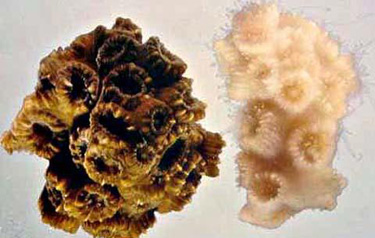Coral bleaching, not always bad
 Marine
Marine  Unbleached and bleached coral. Image credit, NOAAWhen a reef of brightly colored corals suddenly turns white, many people think it is a clear sign that the corals are dying and biodiversity will be lost. That assumption is often wrong and can lead to ineffective or wasteful attempts at coral conservation, according to a pair of coral biologists from the University of Essex.
Unbleached and bleached coral. Image credit, NOAAWhen a reef of brightly colored corals suddenly turns white, many people think it is a clear sign that the corals are dying and biodiversity will be lost. That assumption is often wrong and can lead to ineffective or wasteful attempts at coral conservation, according to a pair of coral biologists from the University of Essex.
In a recent article in Global Change Biology, David Suggett and David Smith call for a better understanding of coral bleaching, so management and conservation efforts can be targeted to help coral reefs to persist.
Coral bleaching is a phenomenon in which corals lighten or whiten, as they lose the pigments that impart their characteristic colors. This can occur when corals are exposed to elevated water temperatures, changes in seawater chemistry, and other environmental stressors.
Suggett and Smith note that the news media and public display an ever-increasing interest in coral bleaching events, but these audiences have very narrow understanding of the causes and consequences of bleaching.
Large bleaching events are generally viewed as a catastrophic consequence of global climate change, leading to loss of the biodiversity associated with coral reefs.
The truth, however, is that bleaching happens for many reasons other than global climate change, the corals do not always die, and biodiversity is not necessarily lost.
Bleaching can happen as a normal, beneficial part of reef ecology, enabling corals to acclimatize to changing environmental conditions. Bleaching may occur in response to seasonal changes, or it may be a response to temporary extremes in the environmental conditions, and the corals eventually recover.
In such cases, bleaching may not be a tragedy but positive evidence of resilience, meaning the corals are adjusting as needed to survive.
Awareness of coral bleaching has helped to build support for coral conservation initiatives of government agencies and non-profit organizations, but widespread misperceptions about bleaching may cause those initiatives to misdirect their efforts, according to Suggett and Smith.
They propose three ways for scientists to improve understanding of coral bleaching to support better conservation and management:
- Quantify the responses of corals to regular environmental changes, so bleaching events can be placed “within the context of a ‘business as usual’ scenario.”
- Differentiate the bleaching responses of coral species, their susceptibility, and the potential consequences for reef systems.
- Observe bleaching patterns at the coral colony level and implications for overall reef health, such as impacts on grazers and microbes that can help sustain or kill an entire colony.
Someday, conservation practitioners could use this information to tailor their response to each bleaching event based on severity and likely impacts.
In the short term, however, Suggett and Smith identify a “need to improve how well we communicate the nature of bleaching, in particular through the mainstream media and to the general public. Importantly, it is all of our responsibility to alter the public perception that ‘bleaching is always bad’.”
--by Peter Taylor
SUGGETT, D., & SMITH, D. (2010). Interpreting the sign of coral bleaching as friend vs. foe Global Change Biology DOI: 10.1111/j.1365-2486.2009.02155.x




Reader Comments